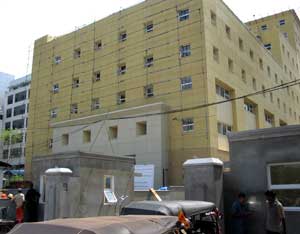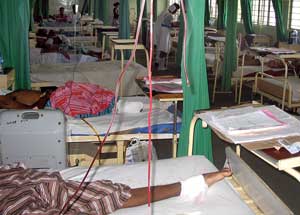Two thousand men, women and children die of head injuries at the National Hospital in Colombo each year.
The statistics are shocking – 45,000 people brought to the OPD of the National Hospital with head injuries each year with 10,000 of them needing admission. Across the country, about 60,000 are admitted to hospitals with head injuries or neuro-trauma, as doctors would call it.
 |
| The Neuro-Trauma Centre now under construction |
Twenty-six-year-old Saman* with his head covered in plaster hardly remembers what happened to him on Tuesday night, except that he was driving his trishaw when he met with an accident at Pasyala. He was rushed to the closest hospital, then transferred to the Accident Service of the National Hospital where he has undergone brain surgery.
Saman is lucky, but what of the 2,000 head-injury victims who, even though they are brought to the National Hospital, die due to lack of facilities. The neurosurgery-wards are crowded, there is no room in the ICU and there is also only one operating theatre for neuro-trauma (See box One).
here are just four beds in the Accident Service ICU for neuro-trauma patients and although a head-injury victim needs monitoring in the ICU for at least 5 to 7 days, at present they can be kept only for one-and-a-half days on average, The Sunday Times understands.
There is also only one operating theatre for neuro-trauma patients, and the terrible consequences of two people who need immediate surgery being brought in can just be imagined.
| Box One |
| A giant leap |
| At Accident Service |
New Neuro -Trauma Centre |
Theatres - 1 |
08 |
| ICU beds - 4 |
66 |
| High Dependency Unit - 0 |
48 |
| Beds for spine-injury victims - 0 |
40 |
| Rehabilitation beds - 0 |
40 |
The doctors would just have to evaluate the two and take in the more seriously injured patient for brain surgery which lasts at least 4-5 hours. The chances of the other patient dying, meanwhile, are very high. The lack of facilities would also leave many people who do survive a head injury, severely disabled with the tragedy being that most of those who die and are paralysed are in the prime of life, it is learnt.
Fortunately, that situation is about to change as soon as the Neuro-trauma Centre now being built in the National Hospital premises is commissioned, The Sunday Times understands. (See box Two)
How does neuro-trauma occur?
It can happen in the home, on the road, in the playground, at a construction site or anywhere for that matter. Road accidents are the most common cause of both head and spinal injuries.
| Box Two |
| Biggest in the world |
About 1,000 head-injury victims who die will be saved when the state-of-the-art Neuro-Trauma Centre now under construction adjacent to the Accident Service of the National Hospital, comes into operation.
Dubbed as the biggest in the world, this Neuro-trauma Centre will have 320 beds for head and spinal injuries including 66 ICU beds; eight operating theatres; OPD facilities; a CT and an MRI scan; a rehabilitation ward; an auditorium; teaching facilities; and a helipad.
The centre is being custom-built under the direction and guidance of neurosurgeons who have given the specifications to the last detail, with funding amounting to US$ 15 million (Rs. 1,500 m) from the Saudi Arabian government. |
When a person is knocked down by a vehicle, the commonest outcome would be that the person loses consciousness with the breathing getting affected or suffers a severe injury which causes massive bleeding, bringing the blood pressure down, said a hospital source when contacted by The Sunday Times.
These two crises have to be tackled immediately, as the brain, one of the most vital organs, needs both oxygen and the blood supply in adequate amounts, otherwise the consequences will be disastrous.
In other countries paramedics rush to the accident site, stabilize the victim and bring him to hospital in a “controlled” manner with oxygen mask etc, The Sunday Times learns, but in Sri Lanka, the injured would be bundled into the closest available vehicle.
The moment the victim is brought to hospital priority is given to resuscitation. The doctors check out the patient’s airway, breathing and circulation. “Ideally resuscitation should be in a well equipped Emergency Treatment Unit followed by continued monitoring in an ICU,” said the hospital source.
 |
| File photo of a crowded neuro surgical ward |
Taking a world reference standard, a normal person would be 15/15 on the Glasgow Coma Scale, with an accident victim who is deeply unconscious being 3/15. Anyone having below 8/15 needs to be intubated and ventilated, in lay terms put on the life-saving machine.
The injuries suffered in an accident could include bleeding into the brain, swelling of the brain or contusions (bruises) of the brain. Therefore, a CT scan is essential to assess the extent of damage, followed by a decision whether to perform brain surgery to remove clots or treat the patient with medication and ventilation or without ventilation.
Thereafter, of course, would be observation of the patient, ideally in the ICU, to pre-empt complications.
At present those with head injuries being brought to the Accident Service of the National Hospital are admitted (10,000 per year) to the Accident Service ICU (with only four beds for neuro-trauma victims) or Ward 72, like all others suffering from different kinds of injuries. The admissions are so many that patients overflow from the beds onto trolleys and also to the floor, with the staff finding it difficult to keep each and everyone under close observation, The Sunday Times learns.
The neuro-surgical team takes over a small number of patients with head injuries needing brain surgery to be accommodated in the Wards 9, 10 and 64 (90 beds). The others have to be in the general surgical wards with no facilities to look after such patients.
But there’s hope for all those who may die or become disabled, as soon as the Neuro-Trauma Centre comes into being. It certainly will help save many a life.
(* Name changed) |


